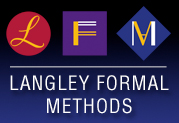Transferring Formal Methods Technology
Because adopting formal methods requires a significant change in philosophy for many companies, successfully transferring advanced formal methods technology to industry can be difficult. However, the situation is changing, and our technology transfer strategy is proving [no pun intended] successful.
The key to successful technology transfer is building a cooperative partnership with a customer. In order for this partnership to work, NASA Langley Research Center must become directly involved in specific problem domains of the aerospace industry. We must also effectively communicate our basic accomplishments in a manner that reveals a significant potential benefit to industry. Equally important, industry must make an investment to work together with us on joint projects to devise demonstration projects that are realistic and practical. The ultimate goal of our technology transfer process is for formal methods to become the state-of-the-practice for U.S. industry development of ultra-reliable digital systems. However, before we can develop new tools and techniques suitable for adoption by industry, we must work with the system developers in industry to understand their needs. We must also overcome the natural skepticism that industry has of any new technology.
Our basic approach to technology transfer is as follows. The first step is to find an industry representative who has become interested in formal methods, believes that there is a potential benefit of such methods, and is willing to work with us. The next step is to either apply formal methods to an appropriate example application ourselves. This process allows the industry representative to see what formal methods is and what it has to offer, and it allows us (the formal methods team) to learn the design and implementation details of state-of-the-practice components so we can better tailor our tools and techniques to industry's needs. If the demonstration project reveals a significant potential benefit, the next stage of the technology transfer process is for the industry representative to initiate an internal formal methods program, and begin a true cooperative partnership with us.
Another important part of our technology transfer strategy is
working with the
Federal Aviation Administration (FAA) to update certification technology
with respect to formal methods. If the certification process
can be redefined in a manner that awards credit for the use
of formal methods, a significant step towards the transfer of this
technology to the commercial aircraft industry will have been accomplished.
to update certification technology
with respect to formal methods. If the certification process
can be redefined in a manner that awards credit for the use
of formal methods, a significant step towards the transfer of this
technology to the commercial aircraft industry will have been accomplished.
In 1990, NASA LaRC initiated a series of workshops on formal methods that eventually became the NASA Formal Methods Symposium.
As another component of our technology transfer strategy, in 1993 we initiated a formal methods subtopic under NASA's Small Business Innovative Research (SBIR) program. Through this subtopic, we hope to be able to assist small businesses to develop commercially viable formal methods tools and techniques.
We also participate in conferences and workshops whenever possible. Also, to facilitate technology transfer, much information on NASA LaRC's formal methods research is publicly available in paper and open source tools. Specific technology transfer projects we have done are described on pages about our specific projects.
The tag![[*]](/images/exlink.gif) identifies links that are outside
the NASA domain
identifies links that are outside
the NASA domain


